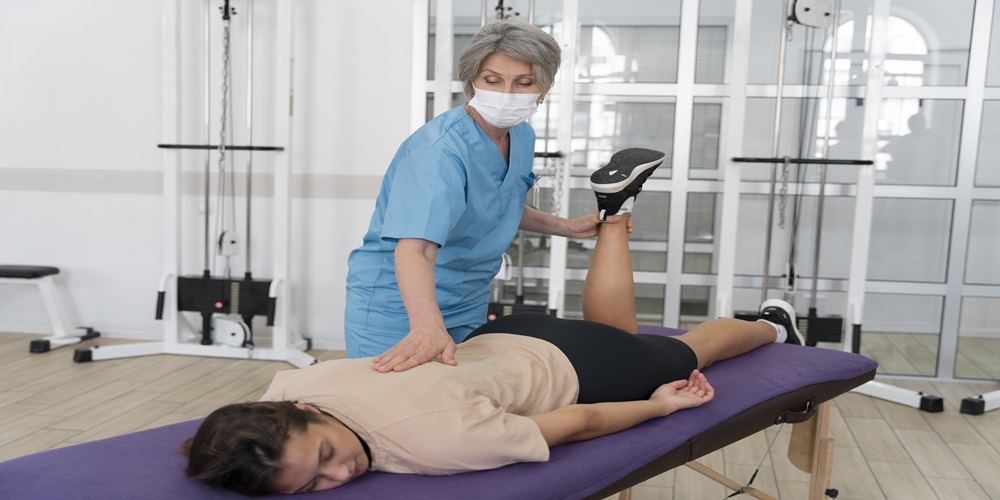Unending pain can massively affect an individual’s yield, challenging even the simplest tasks. While a prescription is often used to handle pain, many people want non-chemical solutions to stop the discomfort. Physiotherapy offers a range of effective non-chemical pain treatment options through a trusted Brampton chiropractor treatment approach. This article explores five standard non-chemical pain management techniques used during physiotherapy sessions, shedding light on how these methods can provide relief without using drugs.

Guided management
Guided therapy mastery, such as massage, joint motivation, and soft tissue handling, are powerful tools in a physiotherapist’s arsenal. By applying proposed pressure and specific movements, experts can suppress muscle tension, improve joint movement, and end pain caused by musculoskeletal conditions. These hands-on techniques promote relaxation, increase blood flow, and facilitate healing, making them a practical, non-chemical approach to pain treatment .
The benefits of manual management go beyond physical wellness. It also suppresses stress and anxiousness, which are often worsened by prolonged pain. Physical treatment can foster health by improving relaxation and freeing muscle tension, contributing to a patient’s mental and emotional health.
Exercise Therapy
Restorative workouts are the basis of physiotherapy treatment. Physiotherapists foster personalized chiropractor care programs for each client’s needs and condition. These exercises aim to improve strength, movement, and extent of motion, ultimately suppressing pain and solving functional capacities. Exercise therapy can also help correct poor posture and body functions, which often contribute to unending pain.
One of the critical benefits of exercise treatment is its life-long aids. By hardening and customizing the body, you can ensure unmatched tolerance to pain, reducing your dependence on prescription. Drills can improve the discharge of endorphins, the body’s natural ache-suppressing chemicals, availing a non-chemical means of managing discomfort.
Electrical excitement
Electrical stimulation, such as Transcutaneous Electrical Nerve Stimulation (TENS) and Interferential Current (IFC), can suppress mild pain. These methods ensure minimal electrical stimulus to the impaired area, reducing pain signals and increasing the discharge of natural ache-reducing chemicals in the body. Electrical stimulation can be particularly helpful for sorting acute and chronic pain conditions.
One of the benefits of electrical motivation is its flexibility. Experts can personalize the range and frequency of the electrical impulses to match each patient’s needs. This ensures a customized and effective treatment approach. Electrical stimulation is a harmless and drug-free option, making it good for those seeking non-chemical pain-suppressing solutions.
Heat and Cold Therapy
The restorative employment of heat and cold can greatly manage pain and inflammation. Heat therapy improves blood flow, relaxes muscles, and enables healing, while cold therapy reduces swelling and inactivates pain. Caregivers may use heat packs, ice packs, or contrast baths to sort specific areas and provide comfort.
Heat and cold therapy can be easily incorporated into a patient’s daily routine, making it a convenient and accessible non-chemical pain management option. These options can be used with other physiotherapy masteries, enhancing their efforts in suppressing discomfort and promoting recovery.
Collaboration with Other Professionals
By working with chiropractors and skilled massage therapists, physiotherapists can add chiropractic mastery and massage treatment into their management plans. Chiropractic attention targets the spine, suppressing pain and improving overall function through physical adjustments and spinal handling. By jointly working with other healthcare experts, physiotherapists can offer innovative chiropractic care argeting each patient’s needs.
This all-round pain management perspective can provide a broad and safe treatment plan, targeting various aspects of a patient’s state. Patients can benefit from the broad and integrated approach to non-chemical pain relief by consulting different healthcare professionals.
Concluding Words
Physiotherapy offers a broad approach to non-chemical pain solutions, sorting the hidden source of discomfort and promoting long-term relief. By combining manual therapy, exercise therapy, electrical stimulation, heat and cold therapy, and collaboration with other professionals, physiotherapists can develop effective treatment plans that alleviate pain without relying solely on medication.
These non-chemical options provide relief and empower individuals to actively participate in their improvement actively, fostering a sense of control and overall well-being.
If you’re struggling with chronic pain or seeking non-chemical alternatives, consider seeking the expertise of a professional physiotherapy clinic. Embrace the power of these non-chemical pain management and embark on a journey towards betterment and a good quality of life. Take the first step today and discover the transformative potential of physiotherapy in managing your pain without relying on medication.